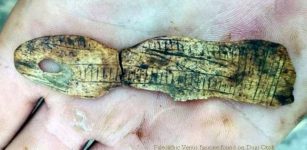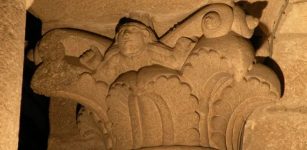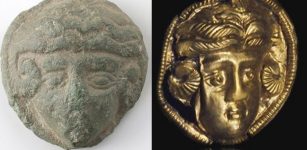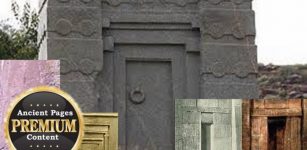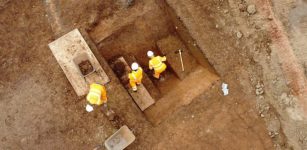Three Grave Steles Unearthed At Istanbul’s 1,500-Year-Old St. Polyeuktos Church
Conny Waters - AncientPages.com - Archaeologists continue excavating the remains of the St. Polyeuktos Church, considered one of the most important structures of the Eastern Roman Empire. This historically valuable landmark was built approximately 1,500 years ago in Istanbul's Saraçhane Archaeology Park.
Image source
The Istanbul Archaeological Museums Directorate focuses on excavations in the underground sections of the church.
“The area where the church is located hosts some of Istanbul's most important archaeological relics, “ said the director of the Istanbul Archaeology Museums, Rahmi Asal, wrote Daily Sabah.
Additionally, Asal said that St. Polyeuktos was the largest and most important structure of its time after the Hagia Sophia. Eastern Roman Princess Anicia Juliana commissioned it to show her power against Emperor Justinian and his non-dynastic wife Theodora.
Therefore, the church embodies many embellishments inside, and a domed basilica is one of the outstanding architectural structures. One of the beautiful decorative elements is, for example, “a beautiful poem on the architrave block, conveying a poetic subject. Beautiful expressions about Anicia Juliana and her family and lineage are included," Asal said.
The remains of the St. Polyeuktos Church, which is considered one of the most important structures of the Eastern Roman Empire, built about 1,500 years ago, are being uncovered through archaeological excavations in Saraçhane, Istanbul, Türkiye, Feb. 2, 2023. (AA Photo)
St. Polyeuktos Church was destroyed during the Latin Invasion and earthquake of 1010; its parts were dismantled and taken to be used in the San Marco Basilica in Venice, and “in construction of other church-like structures in Istanbul and that these walls still survive to this day, “ said Asal.
He also mentioned that in April, a male body statue missing its arms, legs, and head, with only one shoulder bare and wearing a garment known as a "toga," was excavated at the church's site.
Grave Steles Unearthed In Saraçhane Archaeological Park
Hurriyet Daily News informed that the Istanbul Metropolitan Municipality Heritage team unearthed four new artifacts in another wall ruin, just 70 centimeters from the surface of the northern section of the structure, where excavations were carried out. This discovery was made only two months later.
Three of these artifacts were grave steles decorated with various symbols on the grave steles, informing about the status, profession, and interests of the dead ones.
“These finds are extremely important to us in terms of Istanbul's urban history and archaeological richness because the last 100 years of the city are full of rapidly destroyed archaeological sites. Unfortunately, with these losses, the city’s history has been erased and disappeared.
The remains of the St. Polyeuktos Church, which is considered one of the most important structures of the Eastern Roman Empire, built about 1,500 years ago, are being uncovered through archaeological excavations in Saraçhane, Istanbul, Türkiye, Feb. 2, 2023. (AA Photo)
"We are trying to show how valuable the city is with the Polyeuktos excavations, Bukoleon Palace excavations, and lost architectural excavations,” Mahir Polat, the deputy secretary general of the municipality, said.
“The stele, which depicts a female figure, dates between the 3rd and 5th centuries. After finishing the works at Polyeuktos Church, we will move to the part we now call the Roman Palace. In this section, the materials used in the decoration of the palace itself started to appear much more. These artifacts were found 70 centimeters below the excavation level.
This is an area where there is such an enormous cultural data, and it is an area where careful excavations should continue.”
The ancient site of St. Polyeuktos Church has undoubtedly much more to reveal in further excavations. There are plans to organize an open museum and archaeology park, which can be visited by locals and tourists. There are plans to organize the excavation area as an open museum and archaeology park, which can be visited by locals and tourists.
See also: More Archaeology News
Finally, Polat said that “it was a big city center at a time before Hagia Sophia was built 1,500 years ago. Considering the size of this excavation area, I can say that an archaeological treasure awaits Istanbul again with enormous finds. We don’t know the surprises this area may bring to us.”
Written by Conny Waters - AncientPages.com Staff Writer









